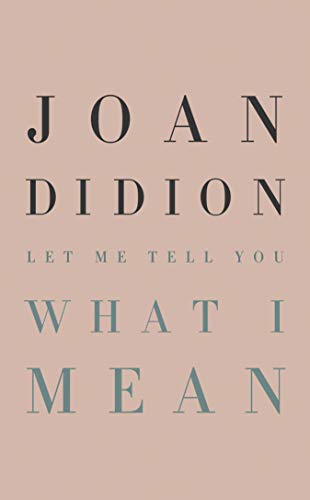
For those of us who love Joan Didion’s writing, we who can imagine her arched eyebrow as she crafts another perfectly turned phrase that is both sardonic and heartbreaking, Let Me Tell You What I Mean is a brief and wonderful gift. For someone like Megan Reynolds, author of “The Long Con of Joan Didion,” maybe not so much. This is a small (5 ½ by 7 inch) and short (149 pages) volume, made somewhat thicker by Hilton Als’s 28-page introduction. I mention these numbers partly to give readers a sense of the book’s limited scope, but also in homage to Didion herself, who loves to parse things down to their component parts.
The first six pieces are all quite short and were written in 1968 for the Saturday Evening Post. One might argue that these are throwaway bits of journalism, not serious enough for inclusion in, say, The White Album, and, in a way, one would be right. However, they were all written by Didion at the time when her great gift had already manifested itself in the publication of Slouching Towards Bethlehem, and so each little essay has its own moments of verve. Her essay on the college admissions process, for instance, is prescient and cutting: “I have heard conversations among 16-olds who were exceeded in their skill at manipulative self-promotion only by applicants for large literary grants.” She is equally snide when attending a Gambler’s Anonymous meeting: “I got out fast then, before anyone could say ‘serenity’ again, for it is a word I associate with death, and for several days after that meeting I wanted to be in places where the lights were bright and no one counted days.” Naturally, her portrait of Nancy Reagan as the First Lady of California is dripping with irony, although in this instance Didion primarily employs description rather than commentary to do her mordant work.
Musing on why she is not an “intellectual,” in “Why I Write,” Didion says she could never “forge a mind that could deal with the abstract.” Instead, “My attention veered inexorably back to the specific, to the tangible, to what was generally considered, by everyone I knew then and for that matter have known since, the peripheral. I would try to contemplate the Hegelian dialectic and would find myself concentrating instead on a flowering pear tree outside my window and the particular way the petals fell on my floor.” That’s classic Didion: apparently self-deprecating, but then who among us would prefer someone who contemplates “the Hegelian dialectic” to a person who meditates on the petals of a flowering pear tree?
Later in “Why I Write,” Didion defines a writer as “a person whose most absorbed and passionate hours are spent arranging words on pieces of paper.” Clearly, that speaks to Didion’s own strengths, and the arrangement of words on these pages is, for the most part, eminently satisfying. However, Didion loves lists, and this predilection doesn’t always serve her well. In “Telling Stories,” she spends six pages giving the rejection history of a short story she wrote in the early 1960s. Similarly, her cataloging of the overpriced wares offered by Martha Stewart Living Omnimedia grows tedious rather quickly.
Nevertheless, her essay on Stewart, “everywoman.com,” is one of the more substantial pieces in the book. Discussing late ‘90s academic treatises on the “Guru of Good Taste,” such as “A Look at Linen Closets: Liminality, Structure and Anti-Structure in Martha Stewart Living,” Didion writes: “there remains, both in the bond she makes and in the outrage she provokes, something unaddressed, something pitched, like a dog whistle, too high for traditional textual analysis.” Actually, Didion reckons, what Stewart demonstrates to her fans “is that know-how in the house will translate to can-do outside it. What she offers, and what more strictly professional shelter and food magazines and shows do not, is the promise of transferred manna, transferred luck.” In short, Didion concludes: “This is not a story about a woman who made the best of traditional skills. This is a story about a woman who did her own IPO.”
The essay on Martha Stewart was published in 2000, so there is no mention of her 2004 conspiracy conviction for insider stock trading. Nor, of course, is there any mention of Stewart’s post-prison rehabilitation, which one assumes Didion would have found fascinating. Let Me Tell You What I Mean is essentially a miscellany, and the final essay ends with Stewart still atop her empire, as though time itself were frozen decades ago, and all we Didion fans had to cling to were beautiful fragments.
This review originally appeared in the California Review of Books.
Support the Santa Barbara Independent through a long-term or a single contribution.




You must be logged in to post a comment.